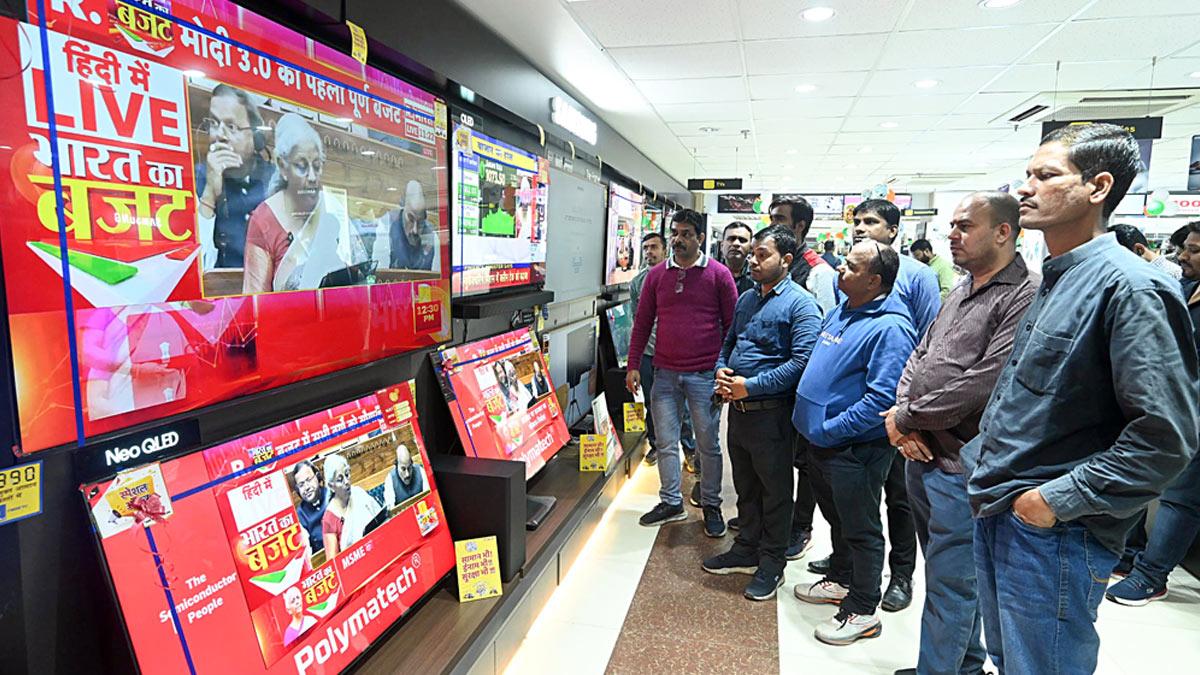‘Nearly 10 million people will benefit from the increase in the rebate limit for those earning up to Rs 12 lakh.’
‘We expect all that money will come back into the economy in either savings, consumption, or investments.’

IMAGE: People watch the live telecast of Union Budget 2025 at a showroom in Patna, February 1, 2025. Photograph: ANI Photo
Union Finance Minister Nirmala Sitharaman, along with her team of top bureaucrats, delved into the fine print of the 2025-2026 Budget at a press conference detailing the road map on tax simplification, capex push and more.
On the new Income Tax Bill
Sitharaman: Any Bill goes to the standing committee and they will consult with stakeholders, and then it will come back to us. If necessary, more amendments can be brought in. I hope it will get passed in this session.
On increasing tax rebate
Finance and Revenue Secretary Tuhin Kanta Pandey: The FM decided that some people should get a little more benefit, therefore an extra rebate of Rs 5 lakh has been given.
Nearly 10 million people will benefit from the increase in the rebate limit for those earning up to Rs 12 lakh. We expect all that money will come back into the economy in either savings, consumption, or investments.
Around 75 per cent of the people have moved to the new tax regime. The old tax regime is available but we expect that everyone will shift to the new regime now.
Sitharaman: We responded to the voice of the people and also made our own assessments; therefore, we have given this.
If you compare it with the 2014 tax rates under the Congress — due to what we did today — somebody earning around Rs 8 lakh now has nearly Rs 1 lakh more in their pocket, and nearly Rs 2 lakh more for those earning Rs 12 lakh.
On capital expenditure
Sitharaman: There is no reduction in public spending on capital expenditure, let’s put that up front.
We continue to place emphasis on the multiplier effect that capital expenditure done by the government has shown. It has sustained us. And with all this, our fiscal prudence has aligned itself to the glide path that we announced in 2020-2021.
This particular year has had the elections, and because of that, both central government and state governments were catching up with investments only from the second and third quarters. Heads of departments where the capital expenditure will happen will vary but expenditure will happen in building assets.
Economic Affairs Secretary Ajay Seth: Effective capital expenditure is 4.3 per cent of GDP. It is not a capacity issue. There are new sectors coming up. The allocations are increasing in the urban sector, for instance.
Expenditure Secretary Manoj Govil: One is the capex that we give directly. The other is the grants that we give to state governments.
If you also include the grants in aid or creation of capital assets, total amount has gone up to Rs 15.48 crore in the Budget Estimate for the next year, which is more than 15 per cent increase over the current year’s Revised Estimate.
On divestment and asset monetisation
Pandey: We have value creation targets, not divestment. Both dividends and divestments should be looked at together.
It has five elements — CPSE performance, communication, capex of CPSE, consistent dividend policy, and fifth a calibrated divestment strategy. Listing is part of it.
If you look at both, Rs 80,000 crore to Rs 90,000 crore has been raised in a manner which is beneficial to minority shareholders.
Sitharaman: Based on the positive reception we’ve had, we are identifying more assets suitable for monetisation. We are in extensive consultations with states, many of which have pinpointed assets they wish to utilise for their own benefit.
Seth: Building on the success we have seen so far, the next phase aims to almost double the efforts, introducing new asset classes, such as transmission assets.
These assets won’t be limited to those owned by the Government of India but will also include assets from state governments. The monetisation plan for these assets will be revealed soon.
The intent behind this monetisation is to reinvest the proceeds from government-owned or PSU assets — like those held by NHAI — into new projects, thereby reinvigorating the economy.
Rather than these funds going directly into the central coffers, they remain with the organisations involved, such as NHAI, which uses them to fund further infrastructure development, like new road projects.
On bilateral investment treaty
Sitharaman: The reason we want to remap is to make it more investor-friendly. With the UAE, it was more than the 2016 version. There is no particular template I’m adhering to; We want to make it more robust and investor friendly.
On tariffs
Sitharaman: The basket, which consisted of so many different tariffs with so many different commodities, is now reduced.
The usual narrative is India is too heavy on tariffs — No. You will find that we drastically reduced and also simplified tariffs.




